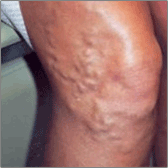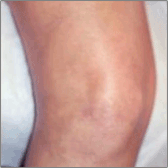

Varicose veins are enlarged veins that can be flesh colored, dark purple or blue. They often look like cords and appear twisted and bulging. They are swollen and raised above the surface of the skin. Varicose veins are commonly found on the backs of the calves or on the inside of the leg.
Spider veins are similar to varicose veins, but they are smaller. They are often red or blue and are closer to the surface of the skin than varicose veins. They can look like tree branches or spider webs with their short jagged lines. Spider veins can be found on the legs and face. They can cover either a very small or very large area of skin.
Vein treatment procedures:
Sclerotherapy: This is a vein treatment in which a solution is injected into the affected area to irritate the vein enough for it to eventually collapse and disappear. This forces other nearby veins to take over blood motion, and can often improve the aching and cramping that is sometimes associated with varicose veins.
Laser surgery: A completely non-invasive vein treatment to make varicose or spider veins fade and disappear, laser surgery sends strong bursts of laser light onto the surface of the vein. There are many types of lasers that may be used to treat varicose veins, and your doctor will choose which will best suit your condition. The duration of the procedure is about 15-60 minutes depending on size of treatment.
Endovenous laser treatment: Endovenous Laser Treatment (EVLT) is only slightly more invasive than regular laser treatment, but can be more effective to treat veins. This procedure involves a tiny, nearly invisible incision made near the affected area and the insertion of a slim laser probe into the varicose vein. Using ultrasound as a guide, your doctor will use laser pulses to seal the affected vein making results immediately visible. The heat from the laser closes and shrinks the varicose vein and causes scar tissue within the vessel. This seals off the vein. Blood then flows through other nearby veins instead.
Ambulatory phlebectomy: This treatment involves the complete removal of the affected vein. Requiring local anesthesia only, this is still considered a minimally invasive procedure. Using a light source to pin-point vein location, tiny incisions are made in the skin adjacent to the affected area, and the vein is removed by surgical hooks.
Endoscopic vein surgery: For more severe varicose veins, endoscopic surgery can be a good treatment. This surgery may take up to two hours, and involves a tiny video camera inserted into the affected veins. A surgical device at the end of the camera is used to close the vein which is then removed via small cuts in the skin.
Surgical ligation and stripping: Ligation involves tying off the vein and limiting blood supply, then removing the vein as other veins deeper in the leg take over blood movement through a process called stripping. Stripping a vein consists of the insertion of a thin wire-like probe that "strips" the vein from the inside.
Closure technique: This procedure is widely believed to become the new standard in varicose vein treatment. A tiny probe is inserted into the vein and sends bursts of radiofrequency energy into the vein to cause its collapse and eventual disappearance.
Recovery time: Depends on the treatment.